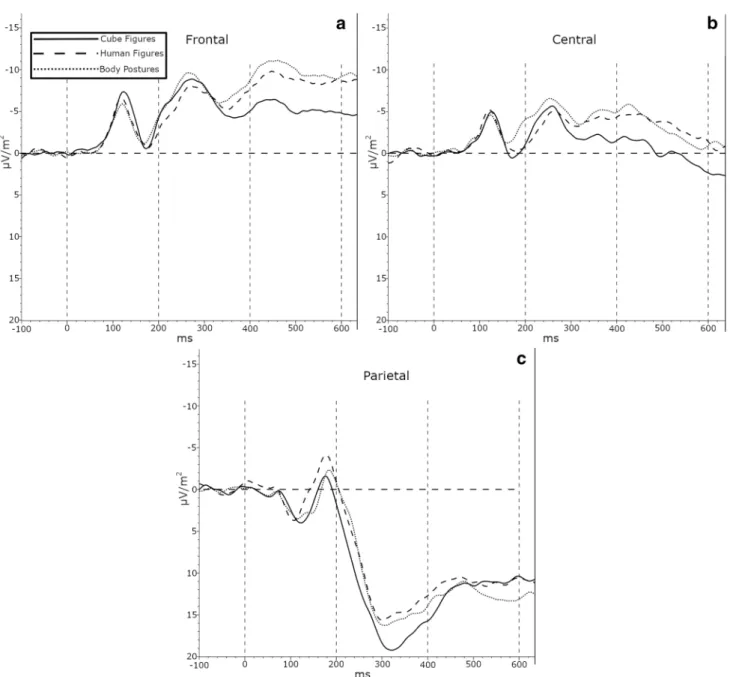https://doi.org/10.1007/s00221-020-05734-w RESEARCH ARTICLE
Mental rotation with abstract and embodied objects as stimuli:
evidence from event‑related potential (ERP)
Petra Jansen
1· Anna Render
1· Clara Scheer
1· Markus Siebertz
1Received: 30 July 2019 / Accepted: 10 January 2020 / Published online: 22 January 2020
© The Author(s) 2020
Abstract
This study investigated sex differences in performance and neuronal activity in a mental rotation task with abstract and embodied figures. Fifty-eight participants (26 females and 32 males) completed a chronometric mental rotation task with cube figures, human figures, and body postures. The results are straightforward: depending on angular disparity, participants had a faster reaction time and a higher accuracy rate for embodied stimuli compared to cube figures. The electroencephalogram (EEG) activity pattern showed a higher negative amplitude modulation in the frontal electrodes for females compared to males during the late (400–600 ms) time interval. From 200 to 400 ms after stimulus onset, there was a different activation pattern in the parietal and central electrodes, whereas frontal electrodes did not show differences between embodied and abstract stimuli. From 400 to 600 ms after stimulus onset, there was a different pattern in the central and frontal electrodes but not in the parietal areas for embodied figures in compared to cube figures. Concluding, even though there were no sex differences in the behavioral data, the EEG data did show alterations at the late time interval. Thus, the disparate results regarding sex differences that depend on the type of analysis (behavioral versus neurophysiological) should be more thoroughly investigated.
Furthermore, the difference in processing embodied stimuli in an object-based mental rotation task could be confirmed in EEG activity pattern for the first time.
Keywords Chronometric mental rotation task · Sex differences · Embodiment · EEG
Introduction
Spatial abilities are highly relevant for everyday activities such as navigation and are also related to, for example, math- ematical ability (Xie et al. 2019). According to Uttal et al.
(2013), spatial abilities can be differentiated according to two dimensions: extrinsic versus intrinsic and static versus dynamic. One of the most investigated spatial abilities is the intrinsic dynamic ability of mental rotation, in which an object is rotated in one’s own mind (Shepard and Met- zler 1971). Mental rotation differs from the spatial ability of perspective taking, which can be classified as extrinsic and dynamic. Two different types of mental rotation transforma- tions are often described: object-based (allocentric, Klatzky
1998) and egocentric mental transformations (Zacks et al.
2000).
Object‑based versus egocentric mental rotation transformations
In the object-based mental rotation transformation task, two stimuli (in normal or mirror-reversed form) are presented.
The participants have to decide whether an object is a mir- rored reversed version of the other object or not. In the ego- centric transformation, e.g., human figures raising their arm (or pictures of hands) are presented and the participants must decide whether it is the left or right arm (or the left or right hand). Pictures of human bodies or parts of human bodies as stimuli (e.g., pictures of hands) in a mental rotation task are called embodied, because the knowledge of the body and its sensorimotor consequences is used for object recogni- tion and transformation (Amorim et al. 2006). It has long been claimed that pictures of abstract or non-human objects, such as cube figures, are processed with an object-based mental transformation, whereas pictures of human bodies
Communicated by John C. Rothwell.
* Petra Jansen petra.jansen@ur.de
1


